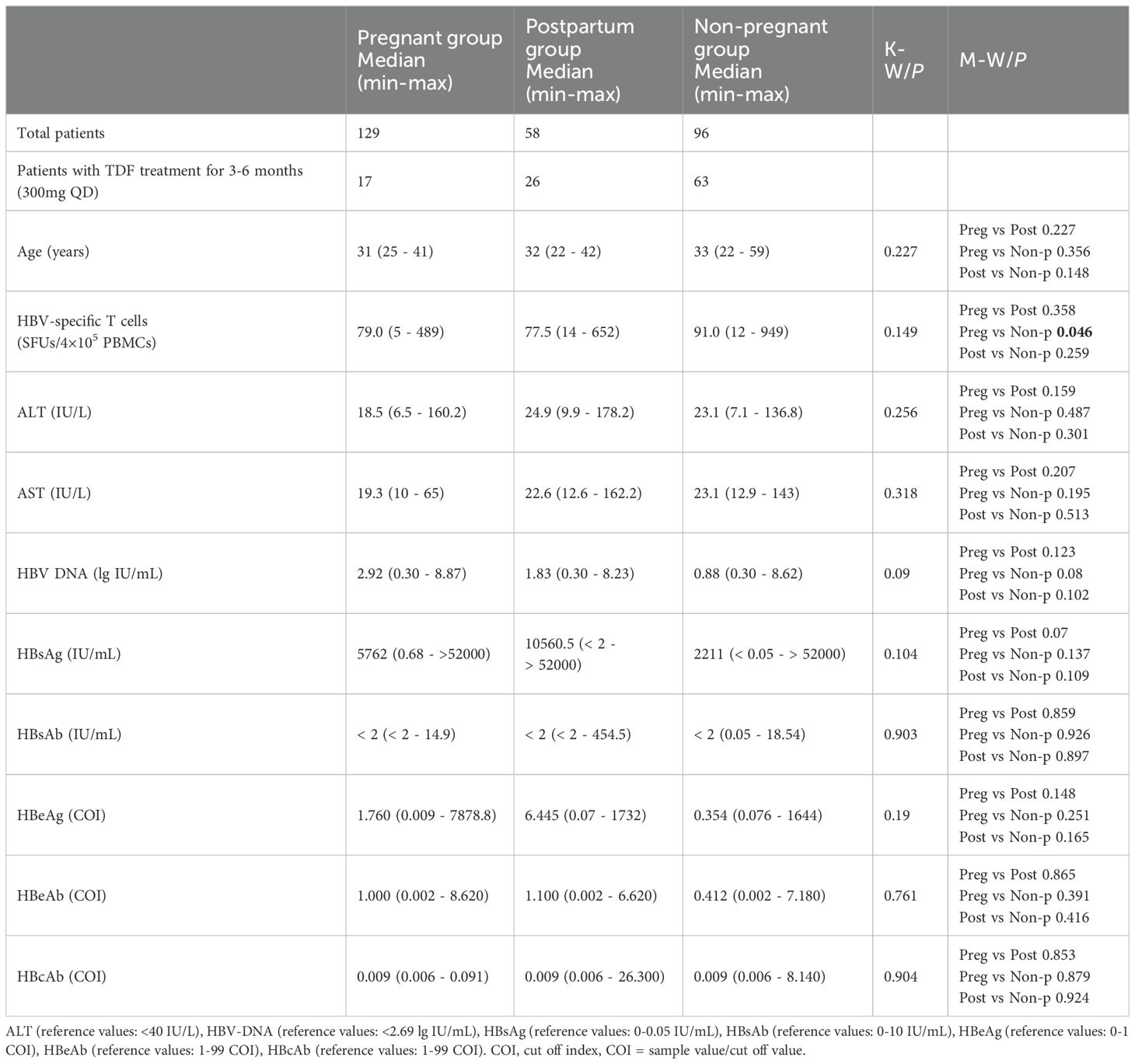- 1Department of Obstetrics and Gynecology, The Second Hospital of Nanjing, Affiliated to Nanjing University of Chinese Medicine, Nanjing, Jiangsu, China
- 2Department of Microbiology and Immunology, Medical School of Southeast University, Nanjing, Jiangsu, China
Objective: To investigate the features of HBV-specific T cell reactivity across the pregnant, postpartum or non-pregnant women with chronic HBV infection.
Methods: A total of 283 patients with chronic HBV infection were enrolled in this study, including 129 patients during pregnancy, 58 patients during postpartum less than 6 months and 96 non-pregnant patients at childbearing age. A universal ELISpot assay was set up using a broad-spectrum T-cell epitope peptide library which containing 103 functionally validated CD8+ T-cell epitopes derived from overall HBsAg, HBc/eAg, HBx and HBpol proteins and fitting to the human leukocyte antigen polymorphisms of Chinese population. Then, The functional HBV-specific T cells in peripheral blood were detected.
Results: The spot-forming units (SFUs) of HBV-specific T cells in the pregnant group showed no statistical difference from the postpartum group, but significantly less than that in the non-pregnant group (p = 0.046). In the untreated patients, the pregnant group displayed HBe/cAg-specific T cells (SFUs) less than the non-pregnant group (P = 0.025) and the postpartum group (P = 0.045). Meanwhile, in the NUCs-treated patients, the three groups presented similar HBV-specific T cell reactivity. Furthermore, the SFUs in the NUCs-treated pregnant group were similar to that in the NUCs-untreated pregnant group. Importantly, ROC analysis demonstrated that the HBV-specific T cells (SFUs) (AUC = 0.742) and combined with HBsAg levels (AUC = 0.775) or with HBeAg level (AUC = 0.78) had a good predictive performance for hepatitis progression during pregnancy group.
Conclusion: Pregnancy can reduce HBV-specific T cell reactivity in the women with chronic HBV infection, and NUCs treatment cannot improve their HBV-specific T cells reactivity. Routine monitoring of HBV-specific T cells during pregnant and postpartum period can provide precise evaluation for immune function and valuable guidance for treatments.
Introduction
Hepatitis B virus (HBV) vaccines have been available for more than 30 years, but the infection has still spread around the world. About 10% of the world’s population is infected with HBV, and more than 257 million of whom suffer from chronic lifelong infection (1, 2). China has the largest burden of HBV infection in the world, with about 70 million people currently infected, and 20-30 million patients with chronic hepatitis B (3). More importantly, maternal-neonatal route is the main way of HBV transmission currently (4). Approximately 75 million women at childbearing age are under chronic HBV infection worldwide (5). For the pregnant woman with chronic HBV infection, the immunity presents special features. For example, the levels of steroid hormones such as estrogen, cortisol and aldosterone are significantly increased, which is one of the reasons for the inhibition of T cell immune function; The success of pregnancy is accompanied by the suppression of immune rejection and the establishment of maternal immune tolerance; Most pregnant women with chronic HBV infection are in the immune tolerance phase, that means high viral load, normal liver function and no clinical symptoms. Around 6-14% of pregnant women progress to hepatitis during pregnancy, and 3.5-50% women progress to hepatitis after delivery, but the immunological mechanism remains unclear (6).
HBV-specific T cell plays a very important role in antiviral infection and is an important factor affecting the disease course and outcome, among which HBV-specific CD8+ T cell-mediated cytotoxic effects play a critical role in clearing the virus. In the patients with chronic hepatitis B (CHB), the specific T cells are mainly manifested by functional exhaustion, such as increased expression of PD-1 and CTLA-4, increased IL-10 secretion and decreased IFN-γ and IL-2 production, or increased Treg cells (7–9). Previous studies have mostly been conducted for the non-pregnant patients. Little is known on HBV-specific T cells in pregnant women with chronic HBV infection. Whether short-term antiviral treatment during pregnancy affects the disease progression in immune-tolerant mothers remains controversial. Clarifying the functional characteristics of HBV-specific T cells during pregnancy will be useful to guide the antiviral therapy and postpartum treatments.
Patients and methods
Patient cohort
A total of 283 patients with chronic HBV infection were enrolled in this study from the Division of Obstetrics and Gynecology at Nanjing Second Hospital, including 129 ones during pregnancy, 58 ones during postpartum less than 6 months and 96 non-pregnant ones at childbearing age. The inclusion criteria are as follows: 1) Female patients aged 20-39 years; 2) Patients who have been HBsAg positive for more than 6 months; 3) Have clinical, biochemical and viral symptoms of chronic HBV infection. The exclusion criteria are as follows: 1) Patients involved in hepatitis A, hepatitis C, human immunodeficiency virus or other viral infections; 2) Those with other chronic liver diseases (autoimmune liver disease, alcoholic liver disease, fatty liver, etc.); 3) Patients with cirrhosis, liver cancer or obstetric diseases (such as intrahepatic cholestasis during pregnancy). The clinical baseline features and nucleos(t)ide analogue (NUC) treatment regimens of these patients are presented in Table 1. All participants provided written informed consent and the Ethics committee approval conforming to the Declaration of Helsinki was obtained from Clinical Ethics Committee of Nanjing Second Hospital (ref: 2024-LS-ky041).
Broad-spectrum HBV CD8+ T-cell epitope peptide library
The CD8+ T-cell epitopes validated in house were incorporated with the CD8+ T-cell epitopes functionally defined by other researchers to establish a HBV-specific antigenic peptide library which contained 103 epitopes. As confirmed by several methods, these epitope peptides were cross-presented by 13 predominant human leucocyte antigen (HLA)-A allotypes (A1101, A2402, A0201, A0207, A3303, A0206, A3001, A0203, A3101, A1102, A0101, A2601, A0301) which gather a total gene frequency of around 95% in Chinese and Northeast Asian populations (10). Then, these validated epitope peptides were grouped into eight peptide pools according to their derived proteins (HBsAg, HBpol, HBx and HBe/cAg), and each protein included two peptide pools. Notably, the 25 epitope peptides in peptide pool 7 and pool 8 were screened and verified from the whole sequence of HBeAg (including the HBcAg sequence) (Supplementary Table S1). Finally, the IFN-γ ELISpot assay was established using the peptide pool array to routinely enumerate the reactive HBV-specific T cells in peripheral blood of HBV-infected patients (11).
ELISpot assay and detection of HBV-specific T cells
Peripheral blood mononuclear cells (PBMCs) were routinely prepared and seeded into 10 wells (4×105 cells/well) in the 96-well ELISpot plates which were pre-coated with human IFN-γ ELISpot capture antibody (BD Biosciences, 1:200 dilution), and cocultured with eight peptide pools for 20 hrs in 5% CO2 incubator at 37°C (one well/peptide pool, 2 μg/peptide/well, totally eight experimental wells). In parallel, negative control well (PBMCs alone) and positive control well (2× 105 PBMCs with phytohemagglutinin, PHA, 2.5 mg/well) were also performed. Notably, in each negative control well, DMSO was supplemented to make its concentration equal to the peptide pool/PBMCs co-culture wells. Then, spots were developed with human IFN-γ detection antibody (BD Pharmingen, 1:250 dilution), streptavidin-HRP (BD Pharmingen, 1:100 dilution) and AEC substrate set (BD Pharmingen,1:50 dilution), according to manufacturer’s protocols. The spot forming units (SFUs) were imaged and enumerated. SFUs in each experimental well = actual spot count in each experimental well - actual spot count in negative control well. When the actual spot count in the indicated experimental well is less than that in the negative control well, SFUs in the indicated experimental well is taken as 0 SFUs. Finally, the total SFUs for eight peptide pools is the sum of SFUs/4×105 PBMCs in eight experimental wells. Meanwhile, the SFUs/4×105 PBMCs for each indicated HBV protein were also calculated according to the peptide pools derived from each protein.
Sero-virological parameters detection
The levels of HBsAg, HBeAg, HBsAb, HBeAb, HBcAb, ALT and AST were quantified using Roche Cobas 8000 Detection System. The HBV DNA load was detected by quantitative real-time PCR and Roche kits. These real-time data from the clinical laboratory of Nanjing Second Hospital were collected at the time point of HBV-specific T cells test for each patient.
Statistical analysis
Statistical analysis was performed using GraphPad Prism 9 (GraphPad, La Jolla, CA, USA). Data were presented as median (interquartile range). A Mann-Whitney (non-parametric) test was used for the analyses of HBV DNA and ALT, SFUs, HBsAg and HBeAg medians between two groups. Kruskal-Wallis test (non-parametric) was performed when analyzing more than two groups. The predictive efficacy of HBV-specific T cells and sero-virological parameters on hepatitis progression in pregnant patients with chronic HBV infection was assessed by receiver operating characteristics (ROC) and area under the ROC curve (AUC). The DeLong test was performed for the comparison of different ROC curves. P < 0.05 was considered statistically significant.
Results
Comparison of HBV-specific T cell reactivity across the pregnant, postpartum and non-pregnant groups
A total of 283 patients with chronic HBV infection were quantified for the numbers of reactive HBV-specific T cells (SFUs) in PBMCs using the ELISpot assay. As shown in Figure 1A, the pregnant patients displayed significantly lower HBV-specific T cell reactivity (median 79 SFUs) than the non-pregnant patients (median 91 SFUs) (p = 0.046), but no difference to the postpartum patients (median 77.5 SFUs). Meanwhile, HBsAg- and HBpol-specific T cell reactivity (median 21 and 17 SFUs) in the pregnant group were also significantly lower than that (median 27 and 23 SFUs) in the non-pregnant group, and similar to that in the postpartum group. In the 174 untreated patients, the pregnant group displayed significantly lower HBeAg/HBcAg-specific T cell reactivity (median 13.5 SFUs) than the non-pregnant group (median 33 SFUs, p = 0.025), and the postpartum group (median 17.5 SFUs, p = 0.045) (Figure 1B). Notably, the 17 pregnant patients and 26 postpartum patients undergoing NUCs therapy for 3-6 months (Tenofovir Disoproxil Fumarate, TDF, 300mg QD) and the 63 non-pregnant patients undergoing NUC or pegIFN-a monotherapy or NUC/pegIFN-a combination therapy presented similar HBV-specific T cell reactivity without significant differences across the three groups (Figure 1C). The spot plots reactive to each peptide pool in the ELISpot assay were presented for six representative patients (Figure 2).
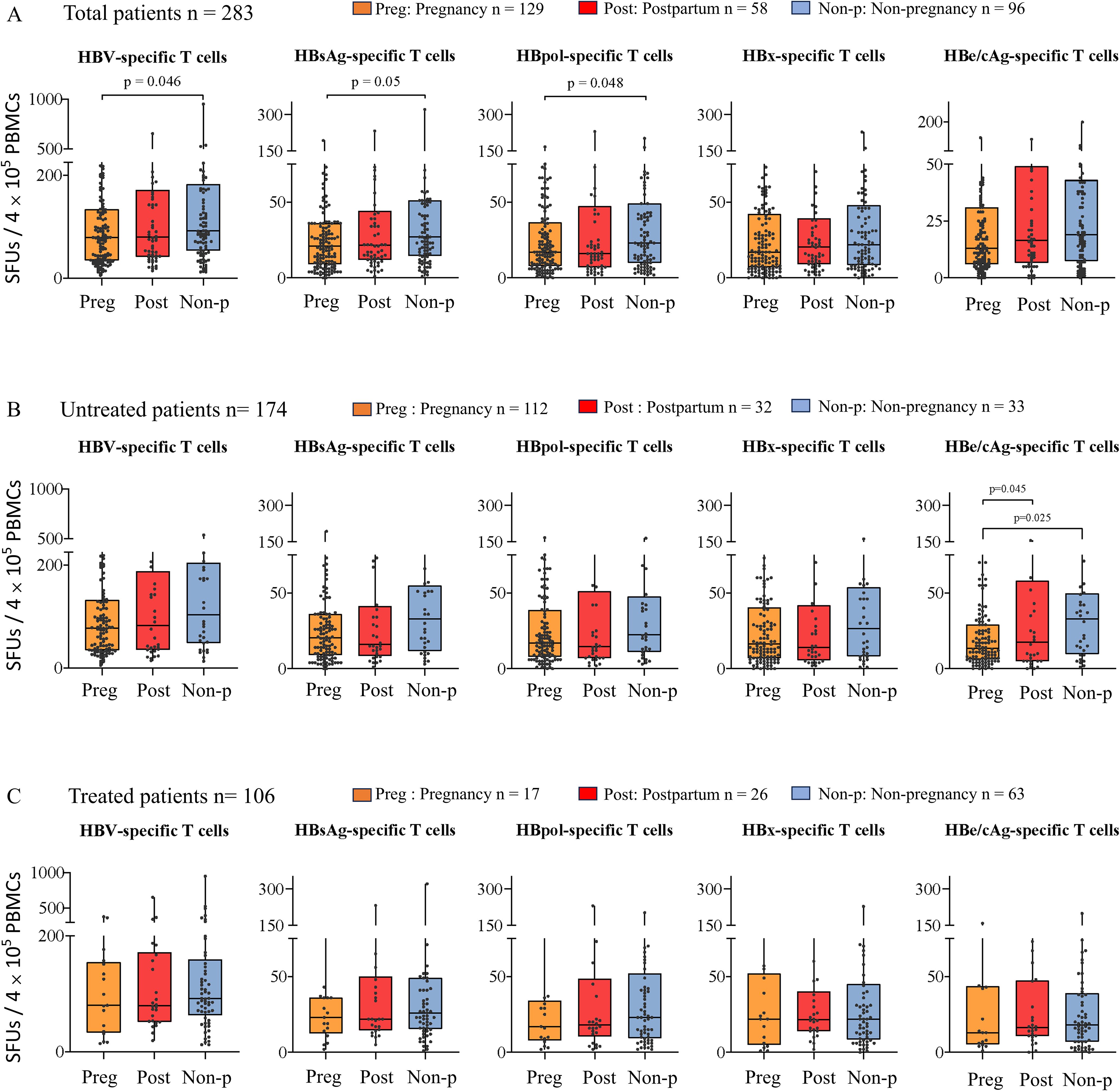
Figure 1. Comparison of HBV-specific T cell reactivity across the pregnant, postpartum and non-pregnant patients with chronic HBV infection. Reactive HBV-specific T cells in PBMCs were detected using ex vivo IFN-γ ELISpot assay and 103 validated T-cell epitope peptides. The total HBV-specific T cells and the indicated antigen-specific T cells (SFUs) in the pregnant, postpartum and non-pregnant groups were presented for 283 patients with chronic HBV infection (A), 174 untreated patients with chronic HBV infection (B), and 106 NUC-treated patients with chronic HBV infection (C).
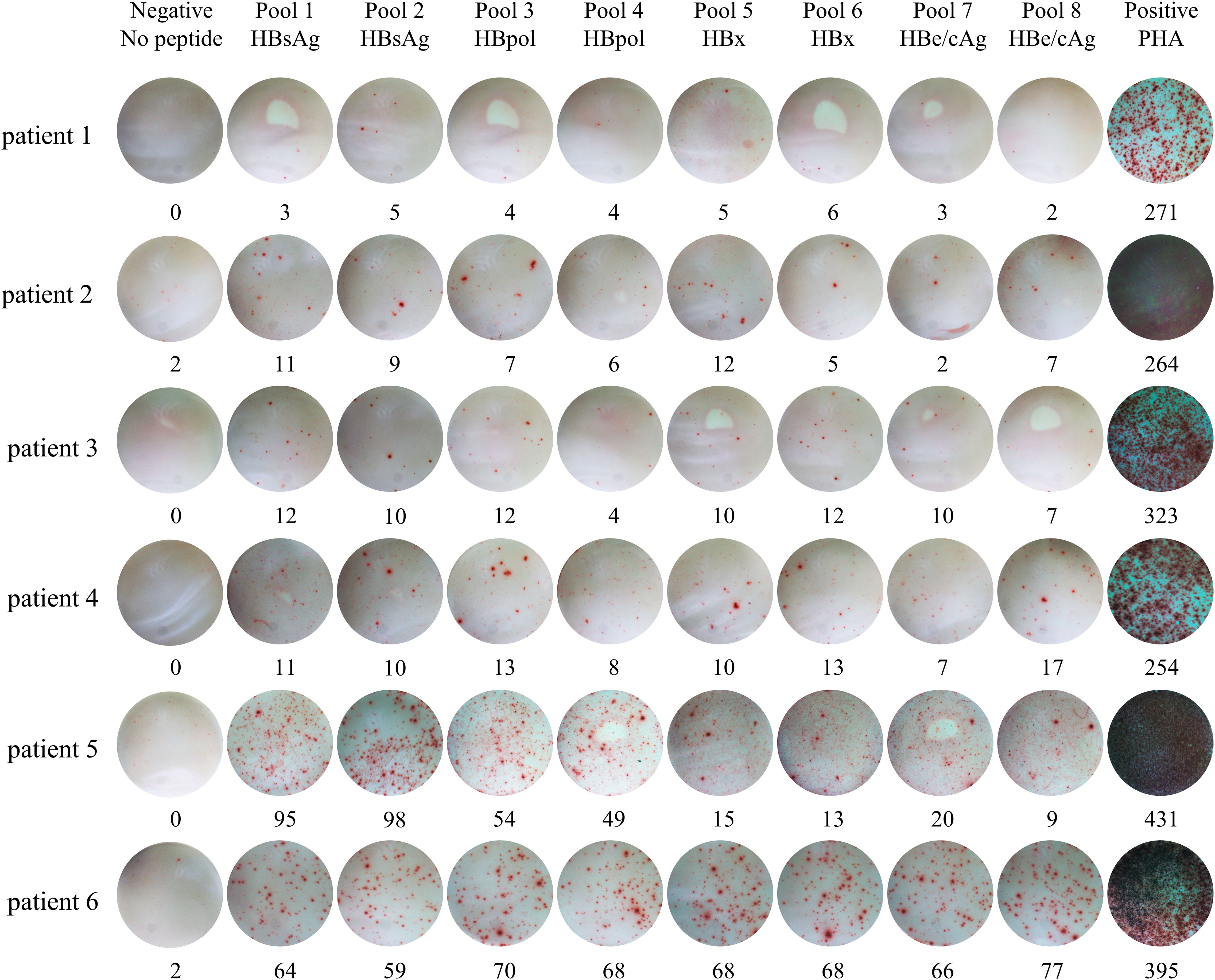
Figure 2. Dot plots of IFN-γ ELISpot assay for six representative pregnant patients with chronic HBV infection. PBMCs from each patient were seed into 10 wells and co-cultured for 20 hours with no peptide, eight peptide pools and PHA, respectively. Then IFN-γ was detected by ELISpot assay. PHA, Phytohemagglutinin.
Stratification analysis of HBV-specific T cell reactivity with clinical and sero-virological parameters
After subgrouping the 129 pregnant patients with chronic HBV infection, the ALT-normal (< 40 IU/L) patients showed significantly higher HBV-specific T cell reactivity (median 80 SFUs) than the ALT-increased (> 40 IU/L) patients (median 47 SFUs) (p = 0.021). Meanwhile, no statistical differences in HBV-specific T cell reactivity were found between subgroups with different levels of AST, viral DNA load, HBsAg and HBeAg (Table 2). In addition, NUCs-treated pregnant patients (TDF, 3-6 months, 300mg QD) showed similar HBV-specific T cell reactivity as the untreated pregnant patients (Table 2). In 58 postpartum patients (within 6 months) with chronic HBV infection, stratification analysis did not find difference in HBV-specific T cell reactivity across the subgroups, including the NUC treated or untreated subgroups (Supplementary Table S2). Among 96 non-pregnant women with chronic HBV infection, the patients with low HBsAg levels (<1000 IU/mL) had significantly lower HBV-specific T cell reactivity (median 71 SFUs) than the patients with moderate levels of HBsAg (1000-20000 IU/mL) (median 105 SFUs, p = 0.044), but no difference from the patients with high HBsAg level (>20000 IU/mL) (median 62 SFUs, p = 0.05) (Supplementary Table S3).
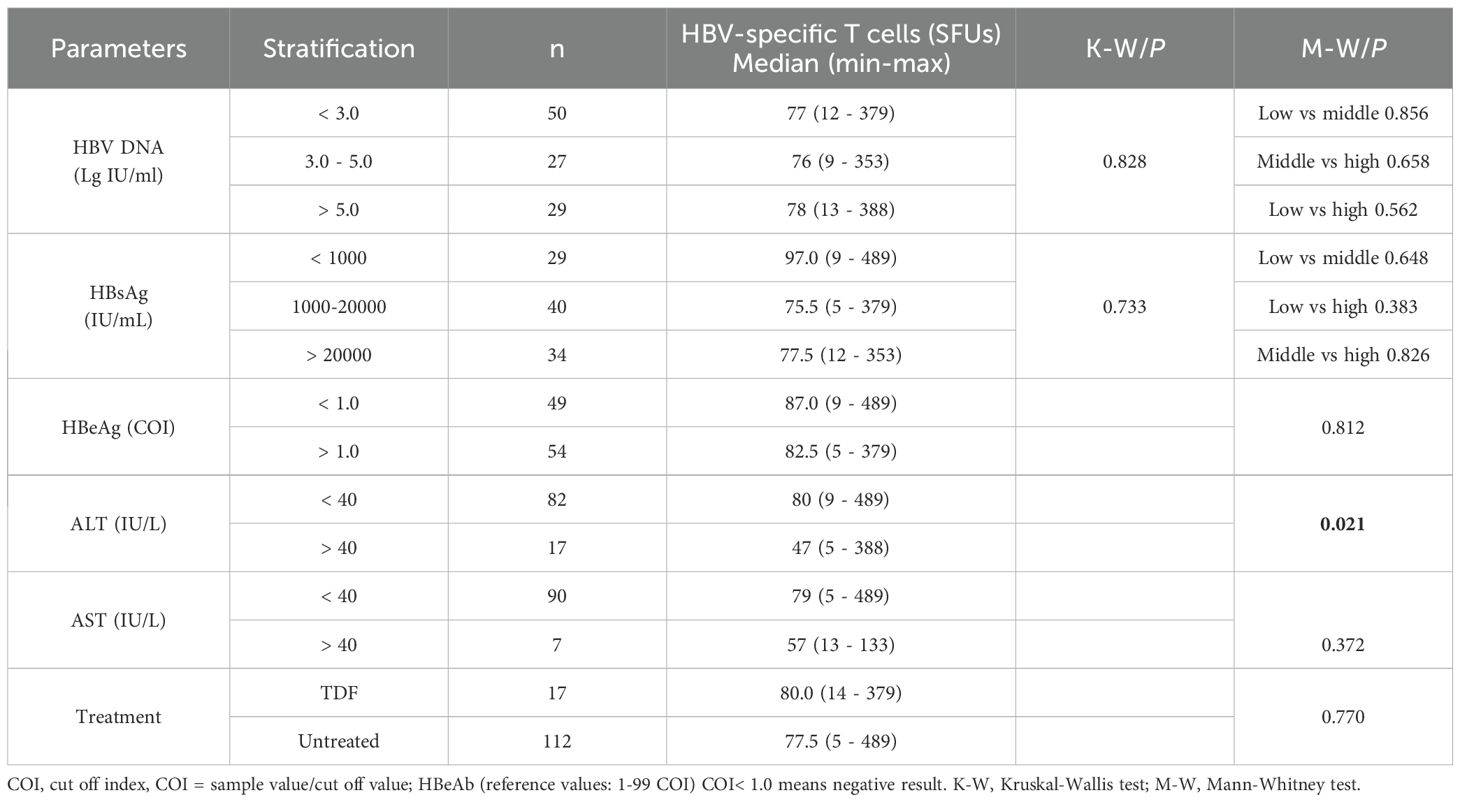
Table 2. Stratification analysis of HBV-specific T cell reactivity for 129 pregnant patients with chronic HBV infection.
The efficacy of HBV-specific T cell reactivity to predict the hepatitis progression in pregnant patients with chronic HBV infection
The predictive power of the number of reactive HBV-specific T cells in PBMCs (SFUs) on hepatitis progression was evaluated for pregnant patients. As shown in Figure 3 and Table 3, HBV-specific T cells presented 0.742 AUC, 56.5 SFUs cut-off value, 75% specificity and 75.9% sensitivity for the liver function at the time point of HBV-specific T cells test, indicating that chronic HBV patients with HBV-specific T-cell reactivity less than 56.5 SFUs/4×105 PBMCs were more likely to develop hepatitis (ALT> 40). Comparably, viral DNA load, HBsAg level and HBeAg level presented a predictive value lower than HBV-specific T cells. But the ROC curves for combined two factors displayed a further increase in predictive accuracy, such as AUC 0.775 for HBV-specific T cells with HBsAg level, and AUC 0.78 for HBV-specific T cells with HBeAg level.

Figure 3. Predictive power of HBV-specific T cell reactivity on hepatitis progression in the pregnant patients with chronic HBV infection. The pregnant patients were divided into normal (ALT <40 IU/L) group and abnormal (ALT >40 IU/L) group according to the liver function at the time point of HBV-specific T cell test. ROC curve analyses of DNA load, HBsAg level, HBeAg level, HBV-specific T cells (SFUs) alone, and a combination of two factors were performed to predict hepatitis progression at the time point of HBV-specific T cell test, using R package pROC, and summarized in Table 3.
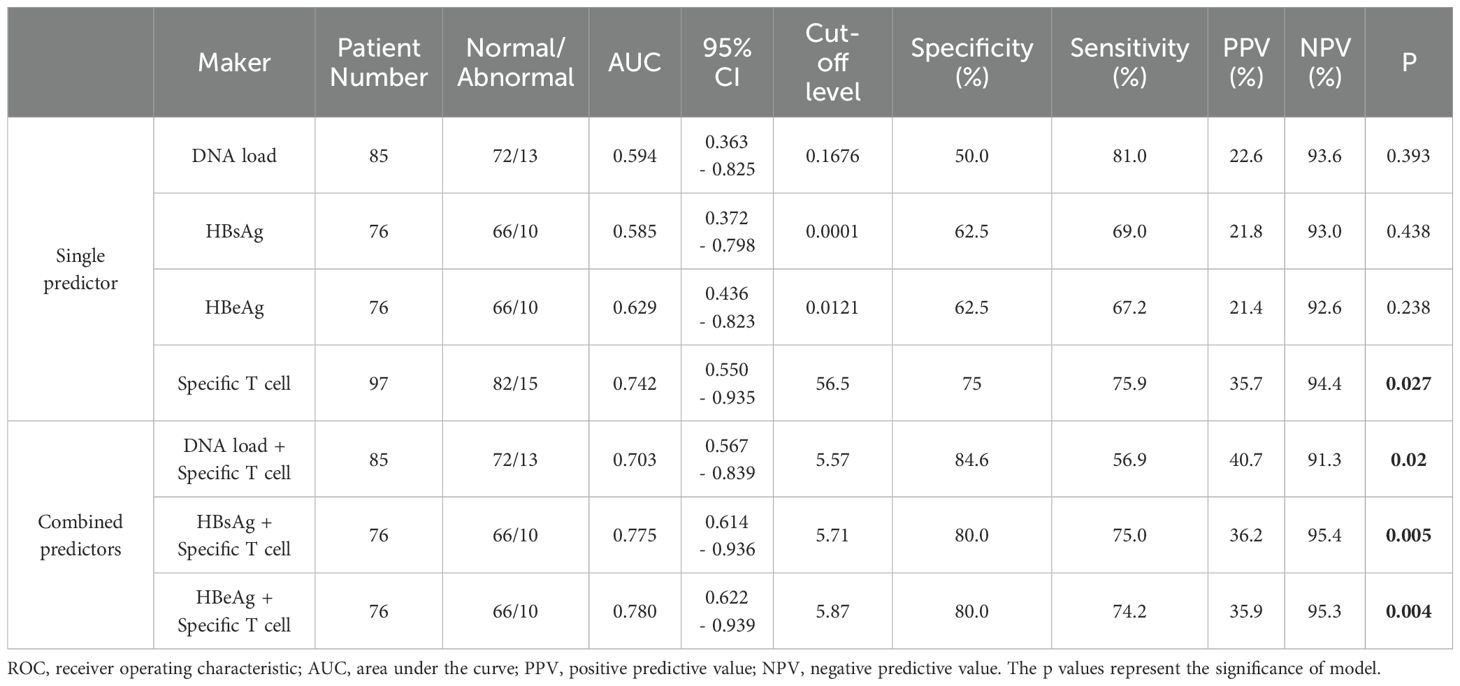
Table 3. Predictive power of HBV-specific T cell reactivity on hepatitis progression in the pregnant patients with chronic HBV infection.
Discussion
Before pregnancy, during pregnancy, prenatal and postpartum, the women with chronic HBV infection need to implement comprehensive monitoring and management. Pregnancy and postpartum can induce hepatitis due to various factors, but there is no specific parameter to monitor and evaluate patient’s ability to clear virus, and to guide the appropriate time point for intervention. The number of reactive HBV-specific T cells is an precise indicator to reflect the specific cellular immune function of host antiviral infection. However, the detection of HBV-specific T cells (number or function) is much more difficult than that of antigens, antibodies and viral DNA, thus it has not been routinely carried out in clinical laboratory so far. The main limitations are as follow: 1) The HLA molecules are highly polymorphic in the population, and the antigen peptides presented by different HLA molecules have distinct sequences; 2) The T cell epitope profile in HBV antigens remains unclear and the validated epitopes are limited. In the past 34 years, only 205 CD8+ T cell epitope peptides and 79 CD4+ T cell epitope peptides have been functionally validated, and they are presented only by a few dominant HLA allotypes, thus these epitopes are unable to cover the main population in an indicated geographical region (12). Consequently, there is no universal and commercial test kit for HBV-specific T cells in clinical or research laboratories at the present.
Among the various methods to detect antigen-specific T cells, ELISpot is one of the most classical methods, which is widely used and recognized by many researchers around the world. It not only has good specificity, low reagent cost, no special instruments, easy to popularize, but also has high sensitivity in which a single cell secreting cytokine can be detected among one million cells (13). Due to the lack of broad-spectrum T-cell epitope peptide library, most of the previous clinical studies on HBV-specific T cells were tested using the overlapping peptide library (14–18) or in silico predicted epitope peptide (19, 20) in ELISpot assay. Unfortunately, both the overlapping and predicted peptide libraries are not real-world epitope peptides verified by cell functional experiments, and recent studies have confirmed that most of them are false epitopes (21–23).
The 103 CD8+ T-cell epitope peptides used in this study were functionally validated using the co-cultures of predicted candidate epitope peptides with the fresh PBMCs from more than 700 HBV-infected patients. Then, the peptide competition experiments of HLA-A molecules were further carried out using 13 engineered HMy2.CIR cell lines expressing the indicated HLA-A molecules, and followed by the molecular docking and molecular dynamics simulation experiments. The results showed that these epitope peptides can be cross-presented by 13 HLA-A allotypes. The gene frequency of each HLA-A allotype is greater than 1% in the Chinese population, and the 13 allotypes can cover more than 95% of the Chinese population. That means the in-house peptide library not only consists of real-world T-cell epitopes of HBV antigens, but also fits to the HLA polymorphism of Chinese cohort, thus can be used for random patients in ELISpot assay (10). Comparably, our data here should be more closer to the real-world functional status of HBV-specific T cells in patients than the data detected by using the overlapping and predicted peptide libraries. In addition, healthy donors were also detected using this system, but presented much higher SFUs numbers compared to the patients due to the vaccination of HBV vaccine for most Chinese individuals, so we think healthy donors cannot be used as negative control group of HBV-specific T cell detection in this study.
Previous studies in non-pregnant patients have shown that the HBV-specific CD8+ T cell responses are barely detectable in the peripheral blood of patients with chronic HBV infection (24), but little information is available in pregnant patients. In this study, the ex vivo ELISpot method was set up using an original and universal kit to quantify the number of reactive HBV-specific T cells (mainly CD8+ T cells), and the results show that the reactivity of HBV-specific T cells was further inhibited during pregnancy as compared with no-pregnant patients, and cannot be improved by TDF treatment. Although clinical experiences have already demonstrated that the treatment with TDF at the late pregnancy can reduce the peripheral HBV DNA load and control the hepatitis progression of pregnant patients with HBV DNA greater than 105 copy/mL, but host anti-viral cellular immunity remains lower than the postpartum or no-pregnant women. The corresponding mechanisms deserve further investigation. In addition, the double-edged relationship of HBV-specific T cell reactivity to liver function remains difficult to be defined. Our data suggest that the number of reactive HBV-specific T cells, as an indicator of host adaptive immunity, is a valued predictor for hepatitis progression in pregnant patients with chronic HBV infection, especially when combined with the HBsAg level or HBeAg level. But a larger patient cohort is needed to further confirm the predictive power for the hepatitis progression 6 months or 12 months later.
Taken together, although the limitations on patient cohort and detection technique, this study truly compared the HBV-specific T cell reactivity across the pregnant, the postpartum within 6 months and non-pregnant women with chronic HBV infection, which provided preliminary observational data for further exploring the characteristics and mechanisms of specific immunity in pregnant women.
Data availability statement
The original contributions presented in the study are included in the article/Supplementary Material. Further inquiries can be directed to the corresponding authors.
Ethics statement
The studies involving humans were approved by Clinical Ethics Committee of Nanjing Second Hospital. The studies were conducted in accordance with the local legislation and institutional requirements. The participants provided their written informed consent to participate in this study.
Author contributions
CS: Conceptualization, Project administration, Supervision, Writing – original draft, Writing – review & editing. GW: Conceptualization, Project administration, Resources, Supervision, Writing – review & editing. FY: Data curation, Formal analysis, Investigation, Methodology, Writing – review & editing. ZZ: Data curation, Investigation, Resources, Writing – review & editing. YW: Formal analysis, Methodology, Writing – review & editing. RJ: Data curation, Investigation, Writing – review & editing. GZ: Data curation, Resources, Writing – review & editing. YJ: Data curation, Resources, Writing – review & editing.
Funding
The author(s) declare financial support was received for the research, authorship, and/or publication of this article. This work was supported by Jiangsu Provincial Science and Technology Fund of China (BE2017714) and Jiangsu Provincial Hygiene and Health Fund (M2020088) as well as National Natural Science Foundation of China (82272402). The sponsors had no role in study design, data collection and analysis, preparation of the manuscript, or decision to submit the article for publication.
Conflict of interest
The authors declare that the research was conducted in the absence of any commercial or financial relationships that could be construed as a potential conflict of interest.
Publisher’s note
All claims expressed in this article are solely those of the authors and do not necessarily represent those of their affiliated organizations, or those of the publisher, the editors and the reviewers. Any product that may be evaluated in this article, or claim that may be made by its manufacturer, is not guaranteed or endorsed by the publisher.
Supplementary material
The Supplementary Material for this article can be found online at: https://www.frontiersin.org/articles/10.3389/fimmu.2024.1461767/full#supplementary-material
Abbreviations
HBV, Hepatitis B Virus; CHB, Chronic Hepatitis B; HBsAg, Hepatitis B surface antigen; HBcAg, Hepatitis B core antigen; HBeAg, Hepatitis B e antigen; HBpol, Hepatitis B polymerase protein; HBx, Hepatitis B X protein; NUCs, Nucleos(t)ide analogue; HLA, Human leukocyte antigens; ELISpot, Enzyme-linked immunosorbent spot; PBMCs, Peripheral blood mononuclear cells; PHA, Phytohemagglutinin; SFUs, Spot forming units; ALT, Alanine aminotransferase; AST, Aspartate aminotransferase; ROC, receiver operating characteristic; AUC, area under the ROC curve; K-W, Kruskal-Wallis test; M-W, Mann-Whitney test.
References
1. Li Q, Sun B, Zhuo Y, Jiang Z, Li R, Lin C, et al. Interferon and interferon-stimulated genes in HBV treatment. Front Immunol. (2022) 13:1034968. doi: 10.3389/fimmu.2022.1034968
2. Hsu YC, Huang DQ, Nguyen MH. Global burden of hepatitis B virus: current status, missed opportunities and a call for action. Nat Rev Gastroenterol hepatol. (2023) 20:524–37. doi: 10.1038/s41575-023-00760-9
3. Liu J, Liang W, Jing W, Liu M. Countdown to 2030: eliminating hepatitis B disease, China. Bull World Health Organization. (2019) 97:230–8. doi: 10.2471/BLT.18.219469
4. Hu Y, Yu H. Prevention strategies of mother-to-child transmission of hepatitis B virus (HBV) infection. Pediatr Invest. (2020) 4:133–7. doi: 10.1002/ped4.12205
5. Yao N, Fu S, Wu Y, Tian Z, Feng Y, Li J, et al. Incidence of mother-to-child transmission of hepatitis B in relation to maternal peripartum antiviral prophylaxis: A systematic review and meta-analysis. Acta obstetricia gynecologica Scandinavica. (2022) 101:1197–206. doi: 10.1111/aogs.v101.11
6. Zhang L, Jiang T, Yang Y, Deng W, Lu H, Wang S, et al. Postpartum hepatitis and host immunity in pregnant women with chronic HBV infection. Front Immunol. (2022) 13:1112234. doi: 10.3389/fimmu.2022.1112234
7. Gu Y, Lian Y, Gu L, Chen L, Li X, Zhou L, et al. Correlations between cytokines produced by T cells and clinical-virological characteristics in untreated chronic hepatitis B patients. BMC Infect diseases. (2019) 19:216. doi: 10.1186/s12879-019-3853-2
8. Dong Y, Li X, Zhang L, Zhu Q, Chen C, Bao J, et al. CD4(+) T cell exhaustion revealed by high PD-1 and LAG-3 expression and the loss of helper T cell function in chronic hepatitis B. BMC Immunol. (2019) 20:27. doi: 10.1186/s12865-019-0309-9
9. Wang H, Luo H, Wan X, Fu X, Mao Q, Xiang X, et al. TNF-α/IFN-γ profile of HBV-specific CD4 T cells is associated with liver damage and viral clearance in chronic HBV infection. J hepatol. (2020) 72:45–56. doi: 10.1016/j.jhep.2019.08.024
10. Ding Y, Zhou Z, Li X, Zhao C, Jin X, Liu X, et al. Screening and identification of HBV epitopes restricted by multiple prevalent HLA-A allotypes. Front Immunol. (2022) 13:847105. doi: 10.3389/fimmu.2022.847105
11. Wu Y, Liu X, Mao Y, Ji R, Xia L, Zhou Z, et al. Routine evaluation of HBV-specific T cell reactivity in chronic hepatitis B using a broad-spectrum T-cell epitope peptide library and ELISpot assay. J Trans Med. (2024) 22. doi: 10.1186/s12967-024-05062-5
12. Wu Y, Ding Y, Shen C. A systematic review of T cell epitopes defined from the proteome of hepatitis B virus. Vaccines. (2022) 10. doi: 10.3390/vaccines10020257
13. Ozenci V, Kouwenhoven M, Huang YM, Kivisäkk P, Link H. Multiple sclerosis is associated with an imbalance between tumour necrosis factor-alpha (TNF-alpha)- and IL-10-secreting blood cells that is corrected by interferon-beta (IFN-beta) treatment. Clin Exp Immunol. (2000) 120:147–53.
14. Rivino L, Le Bert N, Gill US, Kunasegaran K, Cheng Y, Tan DZ, et al. Hepatitis B virus-specific T cells associate with viral control upon nucleos(t)ide-analogue therapy discontinuation. J Clin Invest. (2018) 128:668–81. doi: 10.1172/JCI92812
15. Jacobi FJ, Wild K, Smits M, Zoldan K, Csernalabics B, Flecken T, et al. OX40 stimulation and PD-L1 blockade synergistically augment HBV-specific CD4 T cells in patients with HBeAg-negative infection. J hepatol. (2019) 70:1103–13. doi: 10.1016/j.jhep.2019.02.016
16. Le Bert N, Gill US, Hong M, Kunasegaran K, Tan DZM, Ahmad R, et al. Effects of hepatitis B surface antigen on virus-specific and global T cells in patients with chronic hepatitis B virus infection. Gastroenterology. (2020) 159:652–64. doi: 10.1053/j.gastro.2020.04.019
17. Chen C, Jiang X, Liu X, Guo L, Wang W, Gu S, et al. Identification of the association between HBcAg-specific T cell and viral control in chronic HBV infection using a cultured ELISPOT assay. J leukocyte Biol. (2021) 109:455–65. doi: 10.1002/JLB.5MA0620-023RR
18. Hoogeveen RC, Dijkstra S, Bartsch LM, Drescher HK, Aneja J, Robidoux MP, et al. Hepatitis B virus-specific CD4 T cell responses differentiate functional cure from chronic surface antigen(+) infection. J hepatol. (2022) 77:1276–86. doi: 10.1016/j.jhep.2022.05.041
19. Brinck-Jensen NS, Vorup-Jensen T, Leutscher PD, Erikstrup C, Petersen E. Immunogenicity of twenty peptides representing epitopes of the hepatitis B core and surface antigens by IFN-γ response in chronic and resolved HBV. BMC Immunol. (2015) 16:65. doi: 10.1186/s12865-015-0127-7
20. Aliabadi E, Urbanek-Quaing M, Maasoumy B, Bremer B, Grasshoff M, Li Y, et al. Impact of HBsAg and HBcrAg levels on phenotype and function of HBV-specific T cells in patients with chronic hepatitis B virus infection. Gut. (2022) 71:2300–12. doi: 10.1136/gutjnl-2021-324646
21. Tarke A, Sidney J, Kidd CK, Dan JM, Ramirez SI, Yu ED, et al. Comprehensive analysis of T cell immunodominance and immunoprevalence of SARS-CoV-2 epitopes in COVID-19 cases. Cell Rep Med. (2021) 2:100204. doi: 10.1016/j.xcrm.2021.100204
22. Le Bert N, Tan AT, Kunasegaran K, Tham CYL, Hafezi M, Chia A, et al. SARS-CoV-2-specific T cell immunity in cases of COVID-19 and SARS, and uninfected controls. Nature. (2020) 584:457–62. doi: 10.1038/s41586-020-2550-z
23. Cheng Y, Gunasegaran B, Singh HD, Dutertre CA, Loh CY, Lim JQ, et al. Non-terminally exhausted tumor-resident memory HBV-specific T cell responses correlate with relapse-free survival in hepatocellular carcinoma. Immunity. (2021) 54:1825–40.e7. doi: 10.1016/j.immuni.2021.06.013
Keywords: chronic hepatitis B infection, pregnancy, antigen-specific T cell detection, ELISpot assay, postpartum women
Citation: Wang G, Yue F, Zhang Z, Wu Y, Ji R, Zhou G, Ji Y and Shen C (2024) Comparison of HBV-specific T cell reactivity across the pregnant, postpartum and non-pregnant women with chronic HBV infection. Front. Immunol. 15:1461767. doi: 10.3389/fimmu.2024.1461767
Received: 09 July 2024; Accepted: 25 September 2024;
Published: 10 October 2024.
Edited by:
Marcelo A. Soares, National Cancer Institute (INCA), BrazilReviewed by:
Xiaohua Chen, Shanghai Jiao Tong University, ChinaSéverin Foko, University of the Witwatersrand, South Africa
Copyright © 2024 Wang, Yue, Zhang, Wu, Ji, Zhou, Ji and Shen. This is an open-access article distributed under the terms of the Creative Commons Attribution License (CC BY). The use, distribution or reproduction in other forums is permitted, provided the original author(s) and the copyright owner(s) are credited and that the original publication in this journal is cited, in accordance with accepted academic practice. No use, distribution or reproduction is permitted which does not comply with these terms.
*Correspondence: Genju Wang, d2FuZ2dlbmp1QHNpbmEuY29t; Chuanlai Shen, Y2h1YW5sYWlzaGVuQHNldS5lZHUuY24=
†These authors have contributed equally to this work
‡ORCID: Chuanlai Shen, orcid.org/0000-0002-3748-3742
 Genju Wang1*†
Genju Wang1*† Fangping Yue
Fangping Yue Chuanlai Shen
Chuanlai Shen